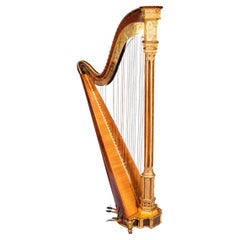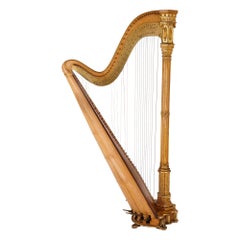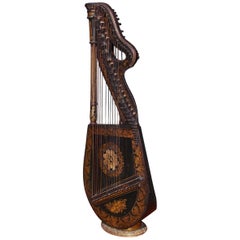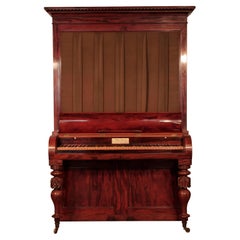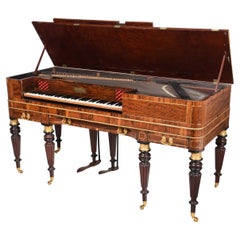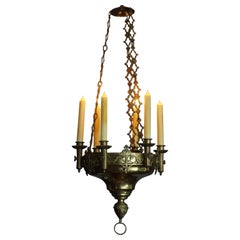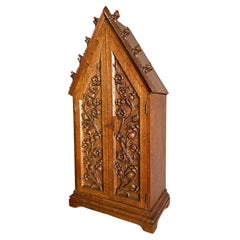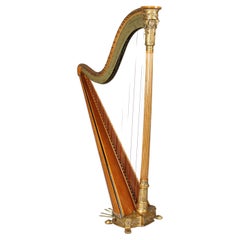Early 19th Century Musical Instruments
13
to
8
4
13
13
13
1
1
1
15
143
346
77
111
142
59
17
6
7
34
15
26
28
29
9
4
9
7
4
3
2
9
4
4
3
2
1
Period: Early 19th Century
Antique coin-operated large double singing birds-in-cage, by Bontems
Located in London, GB
An antique coin-operated large double singing birds-in-cage, by Bontems,
French
circa 1900
Spend a penny in style
When wound and a 1d. coin inse...
Category
French Antique Early 19th Century Musical Instruments
Materials
Gesso
Early 19th Century Parcel Gilt Gothic Revival Harp By Sebastian Erard
Located in Dublin, IE
A very fine and elegant Regency Satinwood and parcel-gilt double action Harp from the workshop of the famous harp and piano maker Sebastian Erard (1752-1831), decorated in the Grecia...
Category
English Gothic Revival Antique Early 19th Century Musical Instruments
Materials
Brass
Antique Gothic Revival Harp by Erard
Located in London, GB
Antique Gothic Revival harp by Erard
French, circa 1840
Measures: Height 178cm, width 54cm, depth 91cm
Of typical form by the famed instrum...
Category
French Gothic Revival Antique Early 19th Century Musical Instruments
Materials
Brass
English Regency Gilt Figural and Ebonized Dital Harp, Maker E. Light, Circa 1815
Located in Hollywood, SC
English Regency gilt stenciled figural and floral ebonized dital harp signed by maker Edward Light. Retailed at Srohl Foley place London, Early 19th century.
Category
English Regency Antique Early 19th Century Musical Instruments
Materials
Giltwood, Ebony, Wood, String
Bates Pianoforte Circa 1825 Carved Baluster Leg 78 Note Fabric Panel
Located in Leeds, GB
Circa 1825, Bates pianoforte. Name plaque in a calligraphy font, sits above the keyboard surrounded by wooden beading. The tall cabinet features a rectangular, cut-out front panel that acts as a sound...
Category
English Antique Early 19th Century Musical Instruments
Materials
Fabric, Wood
Very Fine Classical Rosewood and Bronze Pianoforte, Sack Provenance
Located in Dallas, TX
Available for Curation; Museum quality, Fine classical square grand piano forte by Alpheus Babcock (1785-1842) for G. D. MacKay, Boston", circa 1825...
Category
American American Classical Antique Early 19th Century Musical Instruments
Materials
Brass
Museum Lyre Grand Piano by J.C Schleip Berlin from 1825, Empire
Located in Berlin, DE
Lyre piano attributed to Johann Christian Schleip, Berlin, around 1825, case veneered with mahogany, upper part in the form of a large lyre with 7 wooden sides (lyre), cover and chee...
Category
German Antique Early 19th Century Musical Instruments
Materials
Bronze
Georgian Rare Steel Cased Tuning Fork
Located in Bishop's Stortford, Hertfordshire
A very unusual and rare Georgian antique steel cased tuning fork dating from around 1800. A wonderful piece of musical interest and history the tuning fork...
Category
English George III Antique Early 19th Century Musical Instruments
Materials
Steel
Giraffe Piano by Christoph Ehrlich zu Bamberg, around 1820
Located in Greding, DE
Walnut veneered on spruce with gilded elements and ivory keys. Inscribed on a porcelain plaque. The keyboard has six octaves with six pedals. Playable, tuned...
Category
German Antique Early 19th Century Musical Instruments
Materials
Walnut
English Gothic Style Ibach Upright Piano Carved Oak Traditional Folk Art Motifs
Located in Leeds, GB
English Gothic style, 1895, Ibach upright piano with a carved, oak case and ornate brass candlesticks and handles. Cabinet features traditional folk art motifs and carvings.
Pilasters carved with hearts and stylised trees. Piano cheeks feature a carved sun in a half hex and stylised bird in flight.
Front panel inlaid with folk elements including trinity tulips symbolising faith, hope and charity in a central urn with stylised foliage.
Piano legs are turned with carved spiraling detail .
Piano pedals feature a raised, ornate brass footplate in a curlicue design.
Repeating, carved barrel vaults...
Category
German Gothic Revival Antique Early 19th Century Musical Instruments
Materials
Brass
Pair of Southeast Asian Ceremonial Rain Drums
Located in Houston, TX
Pair of Southeast Asian ceremonial rain drums. Estimated that the bronze drums dates to the early 19th century. The top surface is adorned with a ceremonial star and tops are not tha...
Category
Indonesian Chinese Export Antique Early 19th Century Musical Instruments
Materials
Bronze
Print of Timorese Ladies Playing Harp & Drinking Tea in Kupang, Indonesia, 1825
Located in Langweer, NL
Antique print, titled: 'Coupang: Ile Timor. Divers Costumes.' - ('Coupang, Timor Island. Various costumes').
Three figures in the native dress of the Indonesian island Timor. A y...
Category
Antique Early 19th Century Musical Instruments
Materials
Paper
Japanese Inari Fox Fire Shinto Shrine Temple Edo Period Taiko Drum on Stand
Located in Studio City, CA
This is a truly wonderful and rather unique piece. We can't find another quite like it.
We were told it is from an Edo period Shinto Shrine dedicated to the deity Inari - a popular deity associated with foxes who were known for protecting the annual rice harvest from threatening vermin. In Japanese mythology, foxes are supposed to breathe out flames which are represented by the flame motif at the top of the drum stand...
Category
Japanese Edo Antique Early 19th Century Musical Instruments
Materials
Paint, Wood
Related Items
Early 1900s Gothic Revival Brass and Bronze Church Candle Chandelier / Pendant
Located in Lisse, NL
Practical size and great looking church sanctuary light.
The amount of work that went into creating this striking and practical size chandelier is a...
Category
French Gothic Revival Early 19th Century Musical Instruments
Materials
Brass, Bronze
Free Shipping
H 37 in Dm 15 in
Antique Fine Handcarved Oak Gothic Revival Wall Shrine / Chapel for Statuette
Located in Lisse, NL
Rare and good condition, Gothic-art shrine for standing or wall-hanging.
This handsome and decorative, Gothic wall shrine is completely hand-crafted out of solid oak and it will look awesome, no matter where you decide to mount or place her. It must have taken its creator quite a few days to first draw this intricate design on paper and then hand carve the entire piece out of solid oak. The Gothic Style elements are deeply handcarved in both doors and they make this shrine highly decorative and an absolute joy to own and look at. This cabinet chapel (or chapel cabinet) comes with its brass lock in perfect working order and also with its original gothic style key. The handgrip is in fact a Gothic trefoil symbol (for the trinity). What also makes this piece extra attractive is the Gothic church window-like frame behind the doors. It is among the finest we have seen to date and on top of that this antique also has a beautiful and rich patina. By the way, the bronze Mary statuette is not included in our price. Finally, thanks to the hook in the back, mounting this antique chapel...
Category
French Gothic Revival Early 19th Century Musical Instruments
Materials
Brass
Free Shipping
H 24 in W 11.3 in D 6.1 in
Pair of Gilt Bronze Gothic Revival Altar Pricket Candlesticks w. Lion Sculptures
Located in Lisse, NL
Rare and stunning pair of Flemish, Medieval Style candlesticks with crouching lions.
If you are looking for the best quality and best condition antiques only then this rare pair cou...
Category
European Gothic Revival Early 19th Century Musical Instruments
Materials
Bronze
Free Shipping
H 16.5 in Dm 6.7 in
Fine 19th Century French Neo-Gothic Gilt Metal Cathedral Church Reliquary Pair
Located in Forney, TX
A stunning pair of very fine quality French Neo-Gothic gilt metal church reliquaries. circa 1860s
Most impressive objets d’art, born in France in the second half of the 19th century, most likely Parisian gilded bronze and brass ormolu work, exceptionally executed sculptural form, the exquisitely detailed architectural cathedral shaped case having a removable pointed steeple roof with cross finial, opening to relic display case surrounded on all sides by original glazed glass panes, stepped base, rising on disc feet. Signed, stamped by maker / bronzier "BC" (unknown) model "5096" and other faint marks to lid interiors.
Additional photos available upon request
Dimensions: (approx)
14.75" High, 6.75" Wide, 6.75" Deep; 13.25 lbs total
History:
A reliquary (also referred to as a shrine, by the French term châsse or monstrance) is a container for important religious relics.
The earliest reliquaries were essentially boxes, either simply box-shaped or based on an architectural design, taking the form of a model of a church with a pitched roof. These latter are known by the French term chasse, and typical examples from the 12th to 14th century have wooden frameworks with gilt-copper plaques nailed on, decorated in champlevé enamel. Limoges was the largest production centre; NB the English usage differs from that of the French châsse, which denotes large size rather than shape.
Relics of the True Cross became very popular from the 9th century onward and were housed in magnificent gold and silver cross-shaped reliquaries decorated with enamels and precious stones. From about the end of the 10th century, reliquaries in the shape of the relics they housed also became popular; hence, for instance, the skull of Pope Alexander I was housed in a head-shaped reliquary. Similarly, the bones of saints were often housed in reliquaries that recalled the shape of the original body part, such as an arm or a foot.
A philatory is a transparent reliquary designed to contain and exhibit the bones and relics of saints. This style of reliquary has a viewing portal to view the relic inside. The feretrum was a medieval form of reliquary or shrine containing the sacred effigies and relics of a saint.
During the later Middle Ages, the monstrance form, primarily used for consecrated hosts, was sometimes used for reliquaries. These housed the relic in a rock crystal, or glass capsule mounted on a column above a base, enabling the relic to be displayed to the faithful. Reliquaries in the form of large pieces of metalwork jewellery also appeared around this time, housing tiny relics such as pieces of the Holy Thorn, notably the Holy Thorn Reliquary now in the British Museum.
Condition:
Superb museum quality examples, in excellent original unrestored antique condition with beautifully aged patina. Wear consistent with age and use. Heavily patinated - scattered oxidation. Overall wonderful examples.
Typically reliquaries were not sold in pairs, so to find a matching pair such as this is exceptionally rare.
Worldwide shipping available
Local pickup available near Dallas, Texas
Additional:
We here at Lynx Hollow Antiques love religious antiques, from Christian tabernacles, Catholic altarpiece, life-size Buddhist temple sculptures, Hindu votive offerings, 16th century Islamic mosque architectural salvaged windows...
Category
French Gothic Revival Antique Early 19th Century Musical Instruments
Materials
Brass, Bronze
H 14.75 in W 6.75 in D 6.75 in
Renaissance Period Hand Carved Oak Panels, 16th Century
Located in Beuzevillette, FR
Set of two 16th century oak panels, one representing a character accompanied by a dog, the other a character in flames, probably saints.
These ...
Category
French Renaissance Antique Early 19th Century Musical Instruments
Materials
Oak
Fine American 18th Century Portrait Miniature of a Gentleman
Located in West Palm Beach, FL
Fine American 18th century portrait miniature of a gentleman, of a distinguished gentleman in a blue coat, with white silk scarf, measures 2" wide x 2.5" high. Framed in a later (19th Century) elaborate carved giltwood oval frame...
Category
American American Classical Antique Early 19th Century Musical Instruments
Materials
Glass, Giltwood
French 19th Century Gothic Revival Hand Carved, Lacquered, Parcel Giltwood Spire
Located in Firenze, IT
An impressively large and well detailed French late 19th century architectural model of a Gothic inspired transept-spire or church pinnacle.
This Neo Gothic decorative finial is han...
Category
French Gothic Revival Antique Early 19th Century Musical Instruments
Materials
Wood, Giltwood
H 68.12 in W 20.48 in D 20.48 in
Antique Tile in Frame with Devout Singing Angelic Children Sculptures in Relief
Located in Lisse, NL
Antique and artistic wall tile with religious/spiritual look and feel.
Another one of our recent rare (and possibly unique) finds is this antique wall tile in a wooden Baroque Reviv...
Category
European Arts and Crafts Early 19th Century Musical Instruments
Materials
Ceramic, Wood
Free Shipping
H 9.1 in W 13 in D 1.5 in
Antique Scottish Silver Large Celtic Double Sided JHS Christogram Cross Pendant
Located in New York, NY
Finely detailed antique Scottish silver Celtic cross with exquisitely decorated arms featuring interlaced Medieval style motifs and a central nimbus with a Christogram, the stylized ...
Category
Scottish Medieval Antique Early 19th Century Musical Instruments
Materials
Sterling Silver
H 3.19 in W 1.94 in D 0.08 in
Antique Carved Polychrome Painted Panel Devotional Icon Triptych Altarpiece
Located in Forney, TX
A rustic religious folding three carved wood panel devotional painting icon triptych, 20th century, comprised of three heavily patinated metal hinged shaped wooden panels, decorated in parcel gilt and rich polychrome paint, depicting saint with staff, flanked by two angels. Can be displayed or folded closed.
Dimensions: (approx)
15.5" High, 17" Wide, 0.75" Deep / 2" Deep Closed. 4lbs
A wonderful example of antique religious folk art / Ecclesiastic painting having worn, nicely aged warm and rustic distressed weathered chippy paint finish over the whole, wood losses, attractive imperfections and various antique character marks that add to the distinct beauty and charm.
Similar to a retablo, reredos, altar piece, overdoor, table screen, tabernacle cabinet...
Category
Rustic Early 19th Century Musical Instruments
Materials
Metal
H 15.5 in W 17 in D 0.75 in
French Late 19th Century Neo Gothic Gilded Metal Saint Statue
Located in Buisson, FR
Wonderful gilded metal saint statue with beautiful expression,
France, circa 1880-1900.
Weathered. Measurements include the wooden base.
Category
French Gothic Revival Antique Early 19th Century Musical Instruments
Materials
Metal
Rare & Large Antique Hand Carved Gothic Revival Wall Clock w. Lenzkirch Movement
By Lenzkirch
Located in Lisse, NL
Large and impressive clock with an abundance of Gothic details.
Gothic wall clocks make great decorative antiques and this turn of the century specimen, in our view, has the perfect...
Category
European Gothic Revival Early 19th Century Musical Instruments
Materials
Metal, Brass, Iron
Free Shipping
H 40.5 in W 17 in D 8 in
Previously Available Items
Antique Harpe, Brimmeyr à Paris, Year Of Manufacture: 1826
Located in Greven, DE
Antique harp by Brimmeyr
Workshop Brimmeyr à Paris
wood, stucco
around 1826
Dimensions: H x W x D: 167 x 47 x 80 cm
Description:
Beautiful and extremely elegant pedal harp with 43 strings from the workshop of the famous harp maker Brimmeyr in Paris.
The base of the instrument, standing on paw feet, is elaborately stuccoed with palmettes, hippocamps and lyres. On the back are seven fold...
Category
French Empire Antique Early 19th Century Musical Instruments
Materials
Stucco, Wood
Amazing "LONGMON, CLEMENTI & COMPANY" 1798–1830 Piano
Located in Madrid, ES
"LONGMON, CLEMENTI & COMPANY" 1798–1830
Piano
English in satin wood and other woods.
Folding lid.
Some flaws.
Dim.: 82 x 165 x 60 cm
good conditions
Clementi & Co 1798–1830 Pianofor...
Category
English Baroque Antique Early 19th Century Musical Instruments
Materials
Wood
Large Antique Swiss Ten-Tune Rosewood & Satinwood Inlay Music Box Band, C1890
Located in Big Flats, NY
An oversized antique Swiss music box band offers a instruments to include bells, drum and castanet with cylinder player encased in rosewood box...
Category
Antique Early 19th Century Musical Instruments
Materials
Rosewood, Satinwood
H 9.5 in W 27.5 in D 12.75 in
Columbia No.120 Mahogany Table Top Wind-Up Gramophone
Located in Prato, IT
England, early 1900s
Solid mahogany
The exterior has been repolished with a pad, spirit and shellac.
With fins for sound amplification
Complete with album discs with title index ...
Category
English Edwardian Antique Early 19th Century Musical Instruments
Materials
Mahogany
William iv, Jackson Late Egan Irish Satin & Gilt Wood Harp
Located in Lowestoft, GB
A decorative Irish gilt and satin wood harp in country house condition, produced around 1837/1839.
The Harp is in very much untouched condition, elderly word worn is apparent. The...
Category
Irish William IV Antique Early 19th Century Musical Instruments
Materials
Satinwood
Harp Signed by Sebastian Erard's Patent Harp N. 881 N. 18, 1808-1809
Located in Milan, IT
Harp signed by Sebastian Erard's Patent Harp N. 881 N. 18 Great Marlborough Street London datable between 1808 and 1809.
Erard (Strasbourg, 5th April 1...
Category
British Antique Early 19th Century Musical Instruments
Materials
Wood
H 67.33 in W 37.41 in D 15.75 in
Early 19th Century English Maple and Gilt Bronze Double-Action Harp by J. Erat
Located in Dallas, TX
Decorate a living room or a boudoir with this elegant antique Regency pedal harp. Crafted in England by Jacob. Erat, London circa 1820, the double action musical instrument features 42 recently replaced strings to the gilt foliate faux rosewood sound board. The grained soundboard with five swell doors is further decorated on the inside with hand painted chinoiserie motifs. The fluted column is embellished at the neck with gilded cherub faces, caryatids, leaf decor and ram's head figures. The base decorated with acanthus leaf motifs, is mounted with seven brass pedals on paw feet, and embellished with dolphin figures decorations in gilt. The harp is in good condition with a rich bronze and patinated finish and has engravings which reads: "J. Erat Maker Wardour Street Soho London 878". May need some repairs. We put decorative strings on.
Jacob Erat (1768-1821), the harp maker, worked in the Erard factory as foreman in the late 18th century. He then set up on his own business "The Erat Harp...
Category
English Regency Antique Early 19th Century Musical Instruments
Materials
Bronze
H 66.5 in W 32 in D 28 in
Antique 'Grecian Harp' by Érard
Located in London, GB
This impressive harp by the French maker Érard is stylistically ‘Grecian’, its decorative motifs being drawn largely from Greco-Roman precedents. The Classical influences can be seen in its gilt fluted column, the moulded palmettes present throughout, and the spare and refined gold-and-white colour scheme. The harp is inscribed on the top frame “Sebastian Erard...
Category
English Classical Greek Antique Early 19th Century Musical Instruments
Materials
Ormolu, Bronze
English Mahogany Bronze Mounted and Inlaid Lyre Music Stand on Paw Feet. C. 1800
Located in Hollywood, SC
English mahogany bronze mounted lyre music stand with intertwined floral and musical satinwood inlays, adjustable music rest and telescopic brass cylinder, ...
Category
English George III Antique Early 19th Century Musical Instruments
Materials
Brass
H 60 in W 14 in D 23 in
Lieutenant Rabett’s Seagoing Silver Flute, 1823
Located in Lymington, Hampshire
This rare George IV silver mounted crocus-wood flute was made by Monzani & Co for George William Rabett. It is fitted within a purpose made seagoing Campaign box with an applied brass plaque engraved with the coat of arms, crest and motto of Geo: Wm Rabett. The silver keys with round covers are stamped with a coronet, while the body is impressed Monzani & Co. 28 Regent St Piccadilly London surmounted by a coronet and numbered 2342 and further inlaid with a silver plaque engraved with monogram G.W.R. within a garter and motto, surmounted by the family crest of Rabett. There is also the original key and an extra mouthpiece circa 1825. Hallmarks of Tebaldo Monzani and Henry Hill, London, 1823-1824.
English. 1823-1824
Length of flute approx.: 28 1/3 in (72cm) box, height 3 ½ in (8.5cm), width 14 ½ in (37cm), depth 4 ½ in (11cm)
Born in Verona, Tebaldo Monzani (1762-1839) was a professional flautist, composer, music publisher and innovative instrument maker. Appearing in a London concert for the first time in 1785, Monzani formed a partnership with Giambattista Cimador (1761-1805) and founded ‘The Opera Music Warehouse’ which published, among many others, the operas of Mozart.
Following Cimador’s early death, Monzani formed a new partnership with Henry Hill (1781-1839) as Monzani & Co. specialising in flute making and music publishing. Following Monzani’s retirement in 1829, the firm was continued by his partner as Hill, late Monzani & Co.
George Rabett (1795-1858) entered the Royal Navy inDecember 1810 as midshipman on board Galatea, 42 guns. Soon afterwards Galatea, in company with two other British frigates, engaged three French ships off Madagascar in a ‘long and trying action’ which left 16 of her crew dead and 46 wounded. After further service in the East Indies and Cape of Good Hope, in 1813 Rabett moved to Cydnus, 38 guns, participating in the capture of the United States Privateer Bunker’s Hill and then accompanying the expedition against New Orleans where he joined the army for operations ashore. In the peace, Rabett remained at sea - surviving shipwreck on the coast of Labrador and several months frozen up in the arctic circle - and was made lieutenant in January 1826. He was then appointed to Musquito, 10, in which he participated at the Battle of Navarino on 20 October 1827 and in several other operations during the Greek War of Independence. Returning to England he was made supernumerary in Nelson’s old flagship Victory and given temporary command of the royal tender Onyx serving the young Queen Victoria. However, despite good connections and a long, active and distinguished career during which he was said to have been ‘severely hurt in the execution of his duty’, Rabett never achieved flag rank demonstrating the difficulty of advancement in peacetime. His reputation today largely rests on his widely admired invention, in 1830, of a ‘Substitute Rudder’ to replace a lost rudder at sea although it never seems to have been adopted by the Royal Navy.
Music and dancing played a vital role in maintaining morale and whiling away long hours at sea for both men and officers in the Royal Navy of Rabett’s day. Many captains took private bands on board or sought out and hired accomplished fiddlers to entertain their crews (see Duckworth silver page 46). Officers practised their own instruments - as immortalised by Jack Aubrey’s efforts to master the violin in the Master and Commander...
Category
English Antique Early 19th Century Musical Instruments
Materials
Silver
Ludwig van Beethoven Sonaten Sheet Music Book, C. F. Peters, Leipzig, circa 1820
Located in Sofia, BG
Vintage Leipzig C. F. Peters Beehoven Sonaten Sheet Music Book
Heavy dark green book with gilt gold lettering on cover.
Title page is illustrated in brown and black.
No print dat...
Category
German Arts and Crafts Antique Early 19th Century Musical Instruments
Free Shipping
H 12.21 in W 9.45 in D 1.19 in
19th Century Regency Gilt Wood and Maple English Harp I&I Erat
By I&I Erat
Located in Roma, RM
Fantastic English harp, signed I&I Erat, 23 Berners Street London, N° 1656, early 19th century.
Giltwood and maple with paintings.
Used and played, without strings, not tested.
To...
Category
English Empire Antique Early 19th Century Musical Instruments
Materials
Maple, Giltwood
Recently Viewed
View AllMore Ways To Browse
Brionvega Radio Vintage
Retro Sound Speaker
Antique Swiss Musical Boxes
Vintage Guitars Vintage Musical Instruments
Guitar Vintage Musical Instruments
Baby Baby Grand Piano
Antique Comb Case
Vintage Japanese Radios
Vintage Japanese Radio
Baby Grand Pianos
Phonograph Vintage
Steinway Grand
Vintage Apple Computer
Vintage 1970S Speakers
Zenith Art Deco
Antique Bell Art Collectibles
Antique Beaters
Teak Piano
